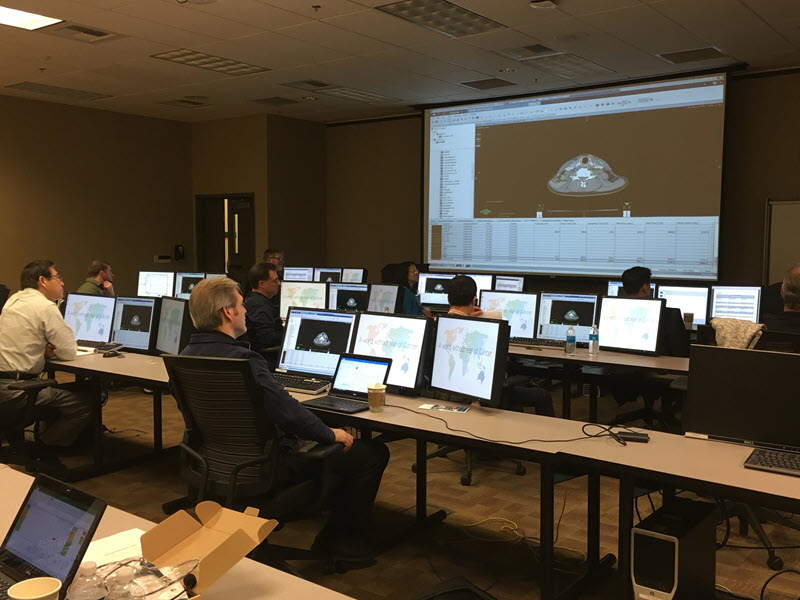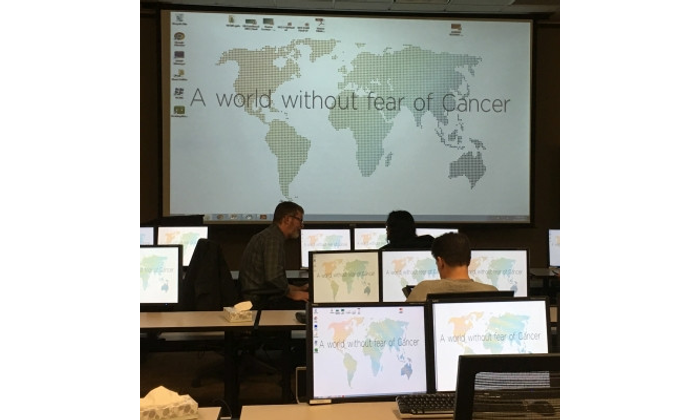Where can you go to hear expert clinicians from places like Cleveland Clinic, Duke University, Fox Chase Cancer Center, Moffitt Cancer Center, UCSD, and UPMC, talk about how to implement advanced radiotherapy treatment modalities like stereotactic radiosurgery (SRS) and stereotactic body radiotherapy (SBRT)? Would you believe: Las Vegas?
Concrete Information for Implementing Advanced Modalities
On a regular basis, Varian convenes a Clinical School (course VC201) at the company’s Las Vegas education center—a unique opportunity for clinical teams to obtain concrete information for implementing advanced modalities. This three-day course systematically covers topics like imaging, protocol choices, positioning and immobilization, contouring, treatment planning, motion management, treatment delivery, and adaptive radiotherapy, proceeding disease site by disease site. It is taught by expert radiation oncologists and physicists from leading cancer centers, who tag-team instruction so that topics are thoroughly covered from both perspectives. Over the course of three days, they conduct highly interactive, case-based presentations organized in six modules covering treatment for cancers of the lung, head and neck, breast, GI, CNS, and GU.
 Clinical School at Varian's Las Vegas training facility
Clinical School at Varian's Las Vegas training facility
During a recent session of the Clinical School, nine radiation oncology professionals from Indiana, Maine, Tennessee, Washington, and Wisconsin were on-hand to take advantage of the information and expertise being offered in a concentrated format. There were individual participants and several teams: groups of doctors, physicists, and dosimetrists attending together in order to pick up as much knowledge as possible, so they could collaborate effectively in launching new SRS/SBRT programs.
 The first presenter was Drew Moghanaki, MD, MPH, from the Medical College of Virginia, who kicked off the lung SBRT module. He covered everything from screening and patients refusing surgery to the need for informed consent, what to do if a patient demands treatment without a biopsy, staging issues and the need to rule out nodal disease, management considerations with early-stage lung cancer, possible treatment approaches, fractionation choices, the “fly with caution” areas of the lung, organs-at-risk limits for peripheral or central tumors; and what to know about reading scans after treatment to avoid unnecessary biopsies. He also covered locally advanced lung cancer, ways of treating with concurrent chemoradiation, the use of 4D imaging with IV contrast, and re-irradiation of recurrent lung cancer. Finally, Dr. Moghanaki provided an overview of the recent and currently accruing randomized trials involving radiotherapy of the lung.
The first presenter was Drew Moghanaki, MD, MPH, from the Medical College of Virginia, who kicked off the lung SBRT module. He covered everything from screening and patients refusing surgery to the need for informed consent, what to do if a patient demands treatment without a biopsy, staging issues and the need to rule out nodal disease, management considerations with early-stage lung cancer, possible treatment approaches, fractionation choices, the “fly with caution” areas of the lung, organs-at-risk limits for peripheral or central tumors; and what to know about reading scans after treatment to avoid unnecessary biopsies. He also covered locally advanced lung cancer, ways of treating with concurrent chemoradiation, the use of 4D imaging with IV contrast, and re-irradiation of recurrent lung cancer. Finally, Dr. Moghanaki provided an overview of the recent and currently accruing randomized trials involving radiotherapy of the lung.
For the second half of the lung module, Todd Atwood, Ph.D., medical physicist from the University of California, San Diego, offered a comprehensive and case-based discussion of imaging and motion management. He shared a decision matrix for choosing between strategies like gating, deep-inspiration breath hold, or expansion of the PTV. He talked about what to document in consultation notes in terms of images used, magnitude of target motion, how the ITV was defined, and other aspects of treatment planning.
The lung module finished up with Dr. Moghanaki demonstrating contouring techniques. He showed how to recognize and trim out any vascular structures that look like a tumor.
The GI module was next, on Monday afternoon. Sarah Hoffe, MD, from Moffitt Cancer Center in Tampa, presented cases from the physician’s perspective, covering liver, pancreatic, esophageal, and rectal cancer. She was followed by medical physicist Derek Brown, Ph.D., from the University of California San Diego, talking about treatment planning and motion management.
On day 2, Thomas Galloway, MD, of Fox Chase Cancer Center in Philadelphia, presented the head and neck module, and Christina Tsien, MD of Washington University in St. Louis, covered the central nervous system, again using case-based examples that generated lively discussions among the participants. A breast module on day 3 was taught by Sushil Beriwal, MD, of UPMC (Pittsburgh), and then Rahul Tendulkar, MD, of the Cleveland Clinic, presented the final GU module. On all three days, classroom instruction was followed by hour-long sessions in the TrueBeam® vault, where operators demonstrated the use of motion management technologies.
 Participants gather for a demo in the treatment machine vault
Participants gather for a demo in the treatment machine vault
Attendees React
“This training has been excellent,” said Scott Gagne, dosimetrist from Maine General Hospital. “I like the comprehensive approach, looking at not just what I do, but how it supports the doctor and the therapist. I’m expanding my understanding and reaching out of the dosimetry niche into the rest of the clinic. We’re usually in our own little worlds. I’m hearing things here that are like little pearls of wisdom that I can take back and share.”
Patrick Melby, dosimetrist from Gundersen Health System in Lacrosse, Wisconsin, enjoyed learning about how things are done in other treatment centers. “I’ve only been in the field for about a year,” he said. “I did my internship at Gundersen and then was hired there, so I only really know the Gundersen way. It’s good to see outside of that. I’ve appreciated hearing about the different treatment approaches, different protocols, and different ways of double checking things to make sure everything is the way we want it to be.”
Advocate Good Shepherd Hospital in Barrington, Illinois, sent Catherine Park, MD, radiation oncologist, plus two members of her team to the Clinical School: physicist, David Park, and dosimetrist, Kim McCall. The center had just acquired a TrueBeam system and was planning to start an SBRT program. It was important that the team attend together for a variety of reasons, Dr. Park said. “By attending the meeting together, we were each able to take away different salient information from different perspectives. By attending as a group, we were able to discuss things during the meeting and determine how to best implement our new SRS/SBRT program.”
“Coming here as a group really does help,” McCall added. “I like to know what’s going on from Dr. Park’s perspective, so I can understand her clinical decisions. Even with the three of us here, sitting in the same sessions, we each key in on something different. Today, during one of the breaks, we were discussing what we heard and how it might impact what we’re going to do in the clinic. With Dr. Park here, I can ask her: ‘What lung SBRT protocols and fractionation schemes are you thinking about using in our department?’ And I can start planning for how to enable her vision.”
When he arrived at Advocate Good Shepherd, physicist David Park already had SBRT experience from working at other centers. Varian’s Clinical School was nonetheless useful in helping him understand the options for delivering SBRT on the TrueBeam system. “It is up to us to understand what the TrueBeam system can do, and to create an SBRT program that fits our center given the specific technology we have,” he said. “Everything is driven by the doctor, but once we understand what she wants to do, we can say: ‘OK. We can make that happen using this method and these tools.’ That’s why it’s so very helpful to come together to a class like this.”
Future Sessions
Additional Clinical Schools are held at pre-eminent treatment centers in North America, including: Henry Ford Health System in Detroit, Ohio State University in Columbus, Princess Margaret Hospital in Toronto, University of Alabama in Birmingham (UAB), University of California San Diego (UCSD), and University of Pittsburgh Medical Center (UPMC). These vary in length and focus. Some operate on a set schedule; some are customized for groups and operate “as needed.” For more information, contact Learning@varian.com.
Similar Clinical School offerings are also available at various sites in Europe and India. Visit our Courses and Training page to see these listings.